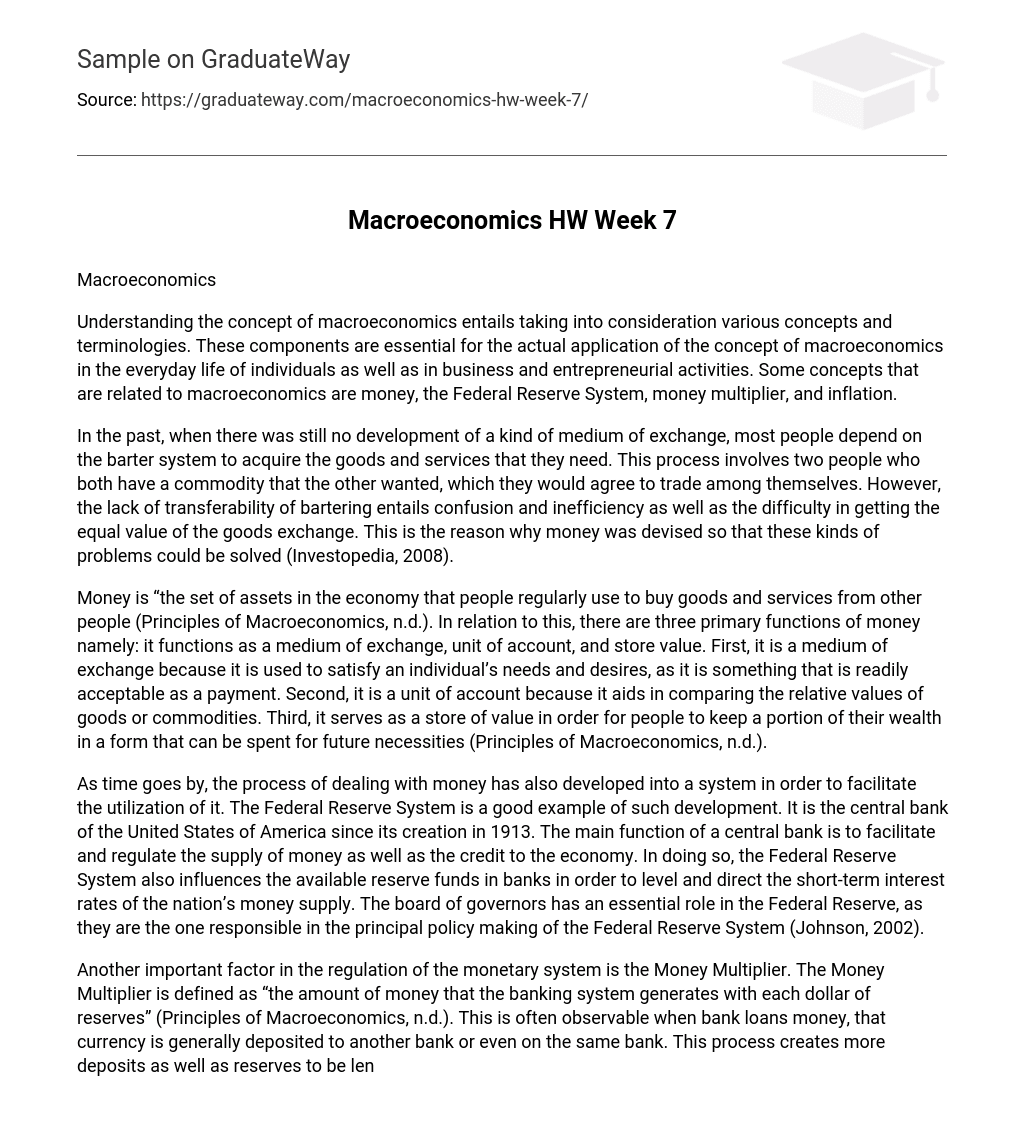Macroeconomics
Understanding the concept of macroeconomics entails taking into consideration various concepts and terminologies. These components are essential for the actual application of the concept of macroeconomics in the everyday life of individuals as well as in business and entrepreneurial activities. Some concepts that are related to macroeconomics are money, the Federal Reserve System, money multiplier, and inflation.
In the past, when there was still no development of a kind of medium of exchange, most people depend on the barter system to acquire the goods and services that they need. This process involves two people who both have a commodity that the other wanted, which they would agree to trade among themselves. However, the lack of transferability of bartering entails confusion and inefficiency as well as the difficulty in getting the equal value of the goods exchange. This is the reason why money was devised so that these kinds of problems could be solved (Investopedia, 2008).
Money is “the set of assets in the economy that people regularly use to buy goods and services from other people (Principles of Macroeconomics, n.d.). In relation to this, there are three primary functions of money namely: it functions as a medium of exchange, unit of account, and store value. First, it is a medium of exchange because it is used to satisfy an individual’s needs and desires, as it is something that is readily acceptable as a payment. Second, it is a unit of account because it aids in comparing the relative values of goods or commodities. Third, it serves as a store of value in order for people to keep a portion of their wealth in a form that can be spent for future necessities (Principles of Macroeconomics, n.d.).
As time goes by, the process of dealing with money has also developed into a system in order to facilitate the utilization of it. The Federal Reserve System is a good example of such development. It is the central bank of the United States of America since its creation in 1913. The main function of a central bank is to facilitate and regulate the supply of money as well as the credit to the economy. In doing so, the Federal Reserve System also influences the available reserve funds in banks in order to level and direct the short-term interest rates of the nation’s money supply. The board of governors has an essential role in the Federal Reserve, as they are the one responsible in the principal policy making of the Federal Reserve System (Johnson, 2002).
Another important factor in the regulation of the monetary system is the Money Multiplier. The Money Multiplier is defined as “the amount of money that the banking system generates with each dollar of reserves” (Principles of Macroeconomics, n.d.). This is often observable when bank loans money, that currency is generally deposited to another bank or even on the same bank. This process creates more deposits as well as reserves to be lent out and thus, the idea of Money Multiplier takes place.
The idea of inflation is also part of the larger perspective of macroeconomics. Inflation is “the overall increase in the general price level” (Financial Guide, 2007). Inflation takes place even if some prices may fall because there is a rise in the cost of living and the cost of business because generally most prices are increasing. Moreover, inflation also reduces the real purchasing power of the consumer that eventually creates business uncertainty (Financial Guide, 2007). Lastly, economists have identified six inflation costs namely: shoeleather costs, menu costs, increased variability of relative prices, unintended tax liability changes, confusion and inconvenience, and the arbitrary redistribution of wealth (Burgees, n.d.).
References
Burgees. (n.d.). Topic11: Money Growth and Inflation. Retrieved July 18, 2008, from
uwadmnweb.uwyo.edu/ECONFINANCE/burgess/Information%20for%20Classes/Econ%201010/Topic11.doc.
Financial Guide. (2007). Glossary. Retrieved July 18, 2008, from
http://www.financial-guide.net/glossary.php?language=en#I.
Investopedia Staff. (2008). What is Money? Investopedia. Retrieved July 18, 2008, from
http://www.investopedia.com/articles/basics/03/061303.asp.
Johnson, M. H. (2002). The Federal Reserve System. The Concise Encyclopedia of Economics.
Retrieved July 18, 2008, from http://www.econlib.org/LIBRARY/Enc/FederalReserveSystem.html.
Principles of Economics. (n.d.). Chapter 15: The Monetary System. Retrieved July 18, 2008,
from bhongybz.com/BHONGYBZ.NET/Resources/Economics/Macroecon/Ch15mac.ppt.





